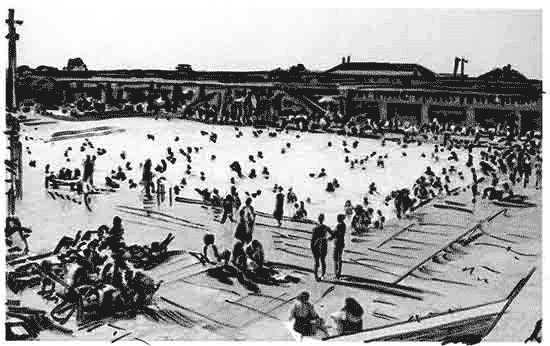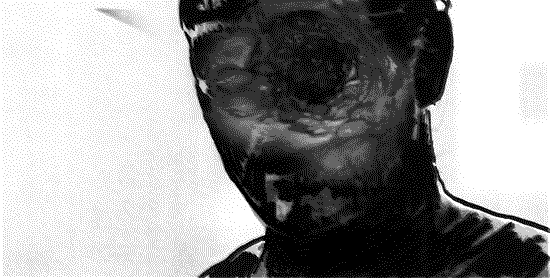A car crash harnesses elements of eroticism, aggression, desire, speed, drama, kinesthetic factors, the stylizing of motion, consumer goods, status—all these in one event. I myself see the car crash as a tremendous sexual event really: a liberation of human and machine libido (if there is such a thing).
—J.G. Ballard, interview in Penthouse (September 1970)
The already-dead term “accelerationism” is productive as a way of thinking and negotiating the register of stupidity—or brutal idiocy—where “meaning” is less important than force. That is, the language of ideology which is neither complex nor beautiful but forceful, articulating “meaning” on the level of flesh as surplus labor, television, academic discourse, and electrocution.1 Spiraling out of the writing of Deleuze and Guattari, Jean-François Lyotard, and Nick Land, among others, accelerationism is a quasi-Marxist strategy where “the cure is posed as more of the disease,” or more of the disease than capitalism can stand. The immanent radicalization of capital’s own dynamic of deterritorialization and decoding. A machinic revolution pressing in the opposite direction to “socialistic regulation,”2 embracing the demonic forces of the market as these rip apart the petty bureaucracies of the State. Played out as either a dehumanizing radicality which (paradoxically) clears the field for a post-capitalist humanism, like the end of Total Recall when the dome cracks open and idealized Life pours out into the regenerating landscape.3 Or as an inversion of Hegelian-Marxist historical materialism, in which capitalism will not be ultimately unmasked as exploited labor power but rather humans unmasked as “the meat puppets of Capital,” and their “identities and self-understandings” as simulations skinned off4—so we can get on “with the business of fully inhabiting inhuman capitalist jouissance.”5 After the Apocalypse the accelerationist either reprograms him or herself back into a “good hippy” or embraces the dark joys of Oblivion like the Nazgûl or Nero in Star Trek 2009.6 But obviously accelerationism doesn’t actually do any of this. A criticism of it is that by strategically endorsing the impersonal processes of neoliberalism, with the alibi of “instrumental distance,” there is no way to dissociate praxis from identifiable ends anymore.7 But this is hypothetical; there is no praxis and capitalism doesn’t need/know/care about any of this. It is like waving a flag as a juggernaut surges past.8


Perhaps then, as Mark Fisher suggests, accelerationism should be considered as a provocation: the kind of provocation the Left needs. Institutional critique—its racy delights pitched strategically and institutionally against the constrained traditions of criticality and (more precisely) the academic Left, or the “embourgeoisified state-subsidized grumbling that so often calls itself academic Marxism.” A menagerie of “careerist sandbaggers,” “guffawing Guardianistas” and “academic trolls” engaged in “quibbling critique” and “the ruthless protection of petit bourgeois interests dressed up as politics.” And all this coagulating around the Kurtz-like figure (and writing) of Nick Land—the dark-brain, enfant-terrible of British philosophy, lurking like a spider in the caves of Mordor (or China). In contrast to the hypocrites described above, Land was on the “outside”—he was earnest, man!—“to the point of psychosis and auto-induced schizophrenia” in his pursuit of “the Spinozist-Nietzschean-Marxist injunction that a theory should not be taken seriously if it remains at the level of representation.”9 Predictably, Land’s anti-careerism is now used by his disciples as cultural capital, with stakeholders and beneficiaries pegged out and lineages coiffured.10 Business as usual.


In part, this is laid out in relation to the same old pseudo-oppositions of philosophical binaries. Nietzsche’s “YES” opposed to the dialectical “NO”; affirmation to dialectical negation; difference to dialectical contradiction; joy, enjoyment, the ecstasy of the event to dialectical labor; lightness, dance to dialectical responsibilities. Life to Death and so on. But there is another way of thinking about all this—key here is the idea of production.
In his book Post-Cinematic Affect, Steven Shaviro makes a proposal for an “accelerationist” aesthetics, despite what he sees as its obvious deficiencies as a “political strategy.”11 As a way of mapping the landscape of contemporary capitalism, exploring the contours of the “prison we find ourselves in,” and as “a meditation on the impossible.”12 In the situation where we are told that There Is No Alternative, this is an aesthetics of the post-impossible after the end of the End of History. OK, so far this is just more of the same.
The immediate problem is that accelerationist aesthetics is already the aesthetics of capital—not the official version obviously (which comes wrapped up in cutesy humanism) but its dark white phosphorus fantasy as vertiginous, desubjectified force—inhuman and “Other.” A porned-up version of Marx where capitalism is always-already everywhere, an abstract, infinite and remorseless evil that “… doesn’t feel pity, or remorse, or fear. And … absolutely will not stop, ever.” A Terminator robot striding across the blackened landscape of post-Fordism swept by the winds of hyperactive production and blasted by the delirious financial flows of neoliberal economy. Hollowed out as the howling wolf-droids of capital’s hyper abstraction and “the repressed desire of capitalism for meltdown.”13 Billions of tons of meat sliding down a chute minced out into surplus value and programed into dull servitude of a bloated homogenizing ruling class (the contingent rule of the bovine). Dark capitalism … you got to crack a few eggs … I mean, exactly how many fucking cuckoo clocks do you want anyway?


Shaviro’s analysis is articulated simultaneously in relation to the transformation of modes of cinematic production and on the level of the sublime. These are interlinked. He describes how the de-particularized spaces through which the protagonist moves (Asia Argento in Boarding Gate [2007]): “corporate offices, loading bays, swank offices, sweat shops …” are engineered as “generic modules that proliferate in order to lubricate the movement of resources, configured to maximize the profitability of space by erecting buildings in relation to the metrics of larger networks of circulation.”15 This is expressed in the movement of the camera roving “nervously back and forth” through the space on the screen regardless of whether it is a murder scene or a shopping mall. Everything is interchangeable, “or at least exchangeable.”16 An aesthetic that presents itself as
the expression of a distilled structure whose sole concern and use is to ramp up levels of efficacy and expediency in the extraction of surplus value and circulation of privatized matter and cognitive production. A developmental ethos that does not hesitate to declare itself a kind of new mathematical sublime: this landscape, with its engineered beams, boxes, piles, glacis, and equipment parks, offers itself as the pure, one-dimensional result of numbers, algorithms, and protocols crunched … elsewhere.17
This is the already-dream of the managers and participants of capital. We luuuuurve it! The fantasy sweep of the vast/incalculable flow of capital in its infinite and unbounded nature played off against the finitude of the worker. An architectural aesthetic where form does not reflect function, but like Albert Speer’s fascist architecture, is the shoddy attempt to fiction it.
Capitalism is not continuous flux, algorithmic automatism, and dematerialized circulation, but instead breakdown, stagflation, crisis, primitive accumulation, violence, and the illusion of growth. It can never perform its own self-image successfully but always falls back on brute power (unnetworked, unambiguous, dumb). It is a system whose strongest production is the production of the image of its own productivity. And obviously these images don’t make sense and so cannot be effectively critically deconstructed or contested. As Žižek says, ideology operates on the register of the sublime, where ideological objects have no meaning, but following Kant’s structuring, our inability to grasp their “meaning” provides testimony to their Transcendent nature—of Nation, God, Freedom, Market, and so forth. Far above the ordinary or profane things of the world, including the limitations of our perceptual/conceptual capabilities. The Truth and force of ideology resides in its lack of meaning.


We don’t live long. This is a simple fact—we don’t live long. And “they” love us for this pathetic temporary-ness, squirted out into the violence and control of language and exchange value, and dying shortly afterwards: a few summer holidays, a few children, 3,000 hours on the toilet and 20,000 hours watching TV. Political transformation requires organization and time but we keep dying. A miserable counter-revolutionary brevity, written precisely into the mechanisms of capitalism as the finite expenditure of labor power, chopped up into small circuits of work and pay, repeated again and again (and our dependence upon this repetition) until death. Replayed to us as the aesthetics of the capitalist sublime and/or Speculative Wowism where the brutal cycles of labor and wage are contrasted with the “infinity” of M-C-M and the myth of its serpent-like omnipresence linked up to Romanticism: “wow it’s amaaaaaazing how vast the universe is and how many stars … and the relentless flow of markets in relation to the finite shitness of our lives.”


The neoliberal End of History and the look-of-love-of-death as sublime wonder carefully cultivated through a series of right-wing think-tanks emerging in the 1940s, encompassing (for instance) the ideas of economist Friedrich Hayek and his development of the Mont Pelerin Society as an attempt to readdress the perceived global slide towards socialism, State ascendency, and Marxist or Keynesian planning. Fictioning a new anti-statist, anti-scientist worldview, prototyped in post-war Germany where “legitimation was achieved through economic growth rather than in political terms.”18 Rearticulating the image of capitalism as unplanned and organic, the economy as a system of flows and State or socialist intervention or planning as “unnatural.” A reversal and reappropriation of nineteenth-century socialist critiques of capitalism as mechanistic with capitalism refictioned as natural/Nature and as the “fact”/Truth of natural selection. As Marx writes:
It is remarkable how among beasts and plants Darwin rediscovers his English society with its division of labor, competition, opening up of new markets, “discoveries” and Malthusian “struggle for existence.”19
The sweep of capital mapped onto the sweep of Nature, its inevitability linked to the inevitability of the trajectory of Life to Death, as in Freud’s articulation of biological conservatism where “all organic instincts are conservative” and “directed towards regression, towards the reinstatement of something earlier. As a return to the inorganic where ‘The goal of all life is death.’”20 Capital as “fact” lined up with the “fact” of Death. Worms. Silvery worms, techno tubes for waste disposal, a writhing mass, disposing of organic material. A twisting mass of annelids and toothed apertures. Hungering mouths. “A writhing mass of words, spoken by many and none. A sermon in the sign of the worm. Bless the coming and going of Him. May His passage cleanse the world.”21


Which is to say that this is all connected up to the circulation of dumb ideas. A space where images float like marshmallows, cutting across institutional, public, private and academic discourse. At the Accelerationism Symposium in 2010, at Goldsmith’s College, the point was made that:
It seems to me simply an aesthetics, a very common extrapolation from a certain lyrical vision of capitalism which to one extent or another you famously encounter in the Communist Manifesto, which simply doesn’t seem to actually involve any theory, if by theory we mean something which could find confirmation or refutation … What strikes me is this is a completely ideological position … [there] might be a mobilizing kick to this, but it’s at a purely ideological level … I wouldn’t say it’s an interesting theory.23
Accelerationism presents the dream of “speed” (or the rate of change of velocity per unit of time) in full-on dumb-Futurist banality. Ray Brassier is right when he describes how Land’s version of accelerationism eliminates the Bergsonian dimension of Deleuze and Guattari’s thought where speed AND slowness is duration and not just linear time.24 Using instead the emptied out idea of “speed” as psychotically speeded-up logical (factory) clock time. Speed as going “faster” than something else which is going “slower.” Speeding us towards the dystopian/utopian horizon of capitalism, as a social form of “pure” drive and accumulation, “freed” from its dependence on the “meat” and slowness of labor.25 Computer acceleration, fire-and-forget warfare, drone attack, and “compression of the kill chain.” Like the imaging of austerity where good mobile, hard-working, entrepreneurial productivity is contrasted against bad lazy, immobile profligacy. Or the dumb circulation of images in the ongoing economy of monarchist zombie-ideology: Margaret Thatcher, the Queen, Mom’s apple pie, Freedom or whatever. For instance, the recent blanket coverage by the British media of the Jubilee and Margaret Thatcher’s funeral. A continuous circulation and saturation. All of which is no less dumb, according to Mark Fisher, than leftist Politics where Badiou and Žižek’s ideas operate as pomo simulations performed for the academic gallery: as comedy Maoism and comedy Stalinism. “The promised land turns out to be a scorched earth where the raddled old communist terms, ideas and histories cannot take root.”26


Real rhythm, as opposed to precisely pulsed meter is, according to Deleuze and Guattari, what “renders duration sonic.” Duration is the détournement of linear, logical time, the rendering pre-posterous of time, where the present is contracted and dilated into the intensive simultaneity of the past and the future of the past, or the future-past of the present; duration is the nonsense of lived time.28
Rotating. A truck rotating. “Flow” but circular. Production grinding round. Not going anywhere but grinding around inside a mine and then the Apple HQ. The movement is relentless but around in circles, grinding a hole in the screen. Revolving. But what if this is not a “stopping” but rotation as a kind of dialectical meat grinder that, to quote Marx, is: a “scandal and abomination to bourgeoisdom” that both recognizes “the existing state of things” and recognizes “the negation of that state.”29 Production-as-production as an aesthetic of repetition. As the terror of the “… P …” of production (in Marx’s formula) as the point where “M” has not been recuperated but put into continuous repetition. As a continuous circulation of production as interruption, withdrawal of labor and anti-accumulation in the fantasy-as-fantasy of an aesthetics of production-as-production. An adjacency to means of production where the production of the capitalist sublime (capitalist aesthetics) is replaced by a blank production of production where the dissimilarity/similarity of “art” and “politics” from/to these generalized categories, by which they are recognized, controlled and rendered impotent, is grinded out as the return of the same as different. Or the continuous potential of this (in repetition). Coiling. Drilling. Screwing. Holing. Sucking. A hole or mouth laughing. Screaming. A vortex to suck the shit through. The angel of history in rotation. Whirlpool Spiral/screw hurricane. A solar anus burning backwards. Production as production.
An abysmal economy of idiocy—forceful and relentless. A form of production as ideology: the ideal expression of “the dominant material relationships grasped as ideas.”30 Accelerationism in this context is a thinking in these transformations of production in/as idiocy (as opposed to rarified reflection from “outside”). An experimentation with the illocutional force of ideas/images which anyway-always operate as forcefully in the context of academia and art as in popular culture, politics, and so on. Whether this is a “theory” or not, it is a sophisticated fictioning of production as illocutional force, sliding in the deathly mud of ideology. Shaviro extends this trajectory in his analysis of the transformation of the modes of production in post-digital cinema where “post-continuity” editing is orientated not towards the production of meaning but “moment-by-moment manipulation of the spectators affective state.”31 The performance of generic stylized (ideological) scenarios, stock characters and images, superseding naive strategies of art-house cinema: complex characterization, narrative, montage, and so forth. Moreover, he proposes that Deleuze’s analysis of cinema in relation to affect and Time Image, is better applied to the “mainstream” examples Shaviro cites than to the films Deleuze himself references (something we all knew already). Accelerationism as an aesthetics presents an alternative to the usual claims to transcendence (through impossible transcendence) as a glimpse of something else, of hopeless hope, institutionally contained negative criticality and other familiar art dreams, but it is trapped by the conception of Time it requires. It is an obvious sideways move to propose, not an accelerationist aesthetics, but a productivist aesthetics where the “image” is not “speed” but repetition, Repetitionism.
The term was coined (negatively) by Benjamin Noys in his Persistence of the Negative: A Critique of Contemporary Continental Philosophy (Edinburgh: Edinburgh University Press, 2010).
From the introduction to Accelerationism Symposium, at Goldsmith’s College (September 14, 2010). Quotation Nick Land, “Machinic Desire,” Textual Practice, Vol. 7, No. 3 (1993).
See the recent “Accelerate: Manifesto For An Accelerationist Politics,” Nick Srnicek and Alex Williams, →.
Mark Fisher, “Terminator vs. Avatar: Notes on Accelerationism,” 2010. See →.
Benjamin Noys, “The Grammar of Neoliberalism,” 2010. See →.
As Alberto Toscano suggests: “‘Enjoying the death of the universe’: is there anything more pitifully human?” Questions after Accelerationism Symposium. See →.
Ray Brassier, “Accelerationism,” Accelerationism Symposium. See →.
Fisher/Brassier, questions after Accelerationism Symposium. See →.
Mark Fisher, “Fans, Vampires, Trolls, Masters,” 2009. See →. See also Fisher, “Terminator vs. Avatar.”
See Fisher, “Mind Games,” Dazed and Confused (May 2011).
Shaviro, Post-Cinematic Affect (London: Zero Books, 2010), 136.
Frederic Jameson, Archeologies of the Future: The Desire Called Utopia and Other Science Fictions (New York: Verso, 2007), 232–33. Quoted in Shaviro, Post-Cinematic Affect, 137.
Reza Negarestani, “Drafting the Inhuman: Conjectures on Capitalism and Organic Necrocracy,” in The Speculative Turn: Continental Materialism and Realism, eds. Levi R. Bryant, Nick Srnicek, and Graham Harman (Melbourne: re.press, 2011), 182–202.
Assisted quotation: T.S. Elliot, The Waste Land, 1922.
Gean Moreno, “Notes on the Inorganic, Part II: Terminal Velocity,” e-flux journal 32 (February 2012). See →.
Shaviro, Post-Cinematic Affect, 46.
Sanford Kwinter, “Generica,” in Mutations (Barcelona: Actar, 2001), 525. Quoted in Moreno “Notes on the Inorganic, Part II.”
Benjamin Noys, “The Grammar of Neoliberalism.”Accelerationism Workshop, Goldsmiths: London (14 September 2010).
Letter from Marx to Engels, June 18, 1862. See →.
Freud, Beyond the Pleasure Principle, 1922.
Frank Herbert, Dune (New York: Ace Books, 1987), 124. See Nicola Masciandaro, “WormSign,” 2011, →.
Stanislav Lem, The Futurology Congress: From the Memoirs of Ijon Tichy, 1971.
Alberto Toscano, questions after Accelerationism Symposium. See →.
Ray Brassier, “Accelerationism,” Accelerationism Symposium. See →.
Noys, “Cyberpunk Phuturism: The Politics of Acceleration,” 2012. See →.
Mark Fisher, “Fans, Vampires, Trolls, Masters.”
Hannah Sawtell, ICA, London, October 9, 2012–November 18, 2012. See →. Including texts by texts by Alun Rowlands and Diedrich Diedrichsen.
Robert Garnett, “The 4th-Dimensional Politics of Rhythm,” Marres/Centrum voor Contemporaine Cultuur Maastricht, 2013. With reference to Franco Berardi Bifo, “Emancipation of the Sign: Poetry and Finance During the Twentieth Century,” e-flux journal 39 (November 2012). See →. Garnett argues for “some rather preposterous claims for the politicality of the pre-posterous: the politics of rhythm exists in its capacity to produce heterogeneous blocs of temporality, rhythmic group subjectivities and becomings-otherwise, reelsewheres, in out of the here and now. Rhythm is the collective investment in the production of desire-production. This is what art or music does politically that politics cannot.”
Marx, Capital, Vol. 1, Afterword to the Second German Edition.”
Marx, The German Ideology, 1846
Shaviro, Post-Cinematic Affect, 118.

